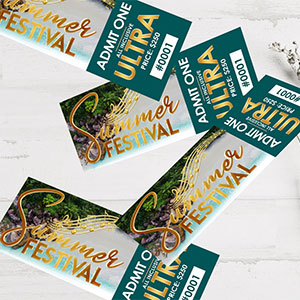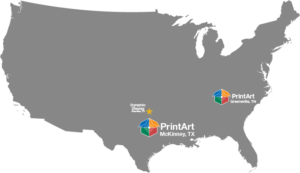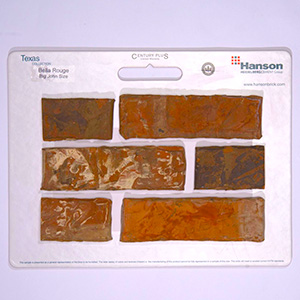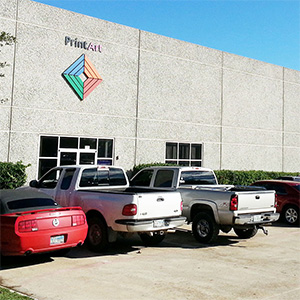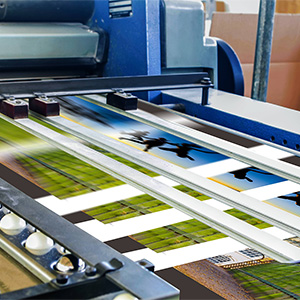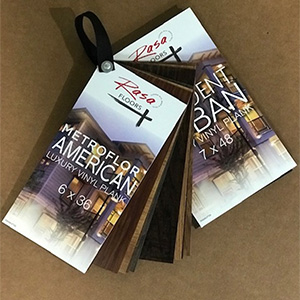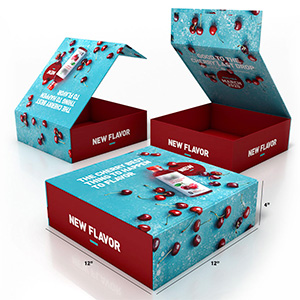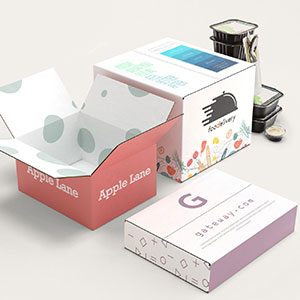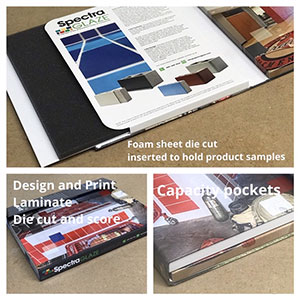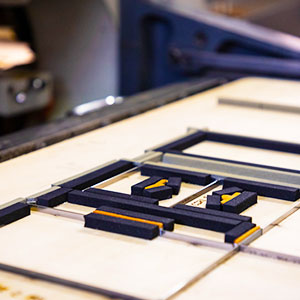Many companies order custom boxes to house information and announcements about new products, to package software, CD/DVD’s and other electronic media, or to have an option over brochures, pocket folders, and binders. This article will help you understand your vast options when requesting custom boxes.
- Corrugated
- Plastic
- Turned Edge
- Setup Boxes
- Aluminum
- SBS
- Wooden
These are just some of the typical types of boxes.
Most people are familiar with shipping cartons made out of thick brown (or kraft) C-flute corrugated board. Inspecting a side cut of C-flute corrugated, you notice it is very wide and thick; good for shipping things but not good for accepting the kind of graphics required to market a product.
E-flute corrugation is only 1/16″ thick, much thinner than the C-flute mentioned above. On some requirements, F-flute or B-flute corrugated may be used. F-flute is very thin (even thinner than E-flute) and is used for very small boxes or boxes that require intricate die-cutting. Surprisingly, B-flute is thinner than C-flute but thicker than E-flute. B-flute is about 1/8th” thick and is used for heavier weight projects.
The corrugated board is usually stocked by the mill and is defined by colors. Brown, Oyster White, White. White is the most expensive board and most sought after for graphic usage. Combinations are available, by special order. Oyster over Kraft or Bleached over Kraft is common. Normally the wavy part of the corrugated board is Kraft.
Decoration of Corrugated
Litho lam: Many customers prefer their corrugated boxes to have the graphics printed on 80# litho paper, which can be filmed, laminated, and mounted to the corrugated. (we call this labeling). Film lamination seals the printing and enables the box hinges to be bent without cracking. The label is attached to the corrugated board before die-cutting. The film lamination can be either glossy or matte (also called de-lustered). A label can be applied to the outside or the inside of the box (also called the liner) or both. The label usually covers the entire box.
Flexo printing: Imagine a big rubber stamp and you now have a good idea of flexo printing. If complex 4 color process graphics is not required then flexo printing may be an alternative to consider. Because flexo printing is not sophisticated, you can only expect the quality of a 65 line screen. This differs dramatically from the 150 line screen quality common in litho printing (labeling). The most cost-efficient type of flexo printing is a flood coat (overall coverage) of a color. Stock printing plates can be used to put the color on the board. However, if graphics or type is required to be reversed out of the solid field or you want to have positive type or graphics, a custom printing plate will have to be made. Flexo plates are priced per square inch. The more graphics or type, the more expensive.
Silkscreen:
For quantities too low to create expensive flexo plates, silk screening can be a cost-effective alternative. Modern technology has made silk-screening almost as clear and sharp as offset printing. We start with your artwork either on a computer disk or good black and white copy. A film positive is made from the art and mounted on to a screen that has been coated with an emulsion. The screen and artwork (on a film positive) are exposed to light for a few minutes. The black of the artwork blocks the emulsion from hardening. The film positive is removed from the screen and the screen is washed with a high-speed water spray. The emulsion where the artwork was is washed away leaving a stencil of the artwork on the screen. The screen is mounted to a press and a squeegee pushes special paints through the screen onto the material for your box.
Silkscreen paints are hand mixed to come as close as possible to a specified color but it is not an exact science. We silkscreen on many different color materials and a hand-mixed Pantone color match will look different when put on colors other than white.
Turned Edge boxes and set up boxes:
Whereas corrugated boxes have “raw edges” where you can see the corrugation, turned edge differ because the board is covered by the wrap. Instead of using a corrugated board, we use different weights of chipboard. In small quantities, these boxes are made by hand. In larger quantities, box making machines are used. Turned edge boxes tend to cost more than corrugated boxes but they have a more finished look. Because chipboard is used, these boxes tend to weigh more than the equivalent corrugated box. Set up boxes are in the category of turned edge boxes. These boxes are commonly referred to as gift boxes and jewelry boxes. Both turned edge and set up boxes can be wrapped in a variety of coverings, film laminated printed paper, linen cloths, fancy paper stocks.
Plastic boxes:
Plastic boxes generally are available in either injection molded plastics or die-cut sheet plastics. Injection-molded boxes tend not to be used for custom purposes as tooling to make custom sizes and shapes are expensive and they are difficult to decorate. Most of our discussion will be on converting sheets of plastic into boxes.
The most common sheet plastics used are polyethylene and polypropylene. Both of these materials can be constructed to form boxes with tuck tabs or can be sonic welded. Sonic welded boxes ship to the customer already assembled. Tuck tab boxes can be shipped flat and assembled by the customer. Both materials come in a variety of thicknesses’ starting at 16 gauge and going up to as high as 75 gauge. The most popular thickness’ are 35 and 55 gauge for polyethylene and 30 gauge and 55 gauge for polypropylene. Polyethylene has been around longer than polypropylene and comes in a wide variety of stock colors and natural (milky clear). Polypropylene is sometimes preferred by customers seeking clear boxes because it can be made crystal clear. Polypropylene tends to be more expensive than polyethylene and has a greater tendency to show scratches and marks with use. For this reason, polypropylene is made on one or both sides with a matte finish or lines to hide the scratches. Clear polypropylene can also come with color tints.
As boxes made of plastic begin as flat sheets they are relatively easy to decorate.
Decoration of plastic:
Silk screening is the most popular technique used in polyethylene and polypropylene. Both these materials have very flat, nonporous surfaces, ideal for silk screening. With modern screening methods, a wide variety of halftones graduated screens and process printing can be accomplished at a reasonable price. Small to moderate quantities of product with complex printing, lend itself to silk screening. See details of the silk screening above.
Litho (offset) printing can be accomplished on lighter gauges of material in larger quantities. In this case, you would ideally begin with a white substrate. Quality can be as good as on coated paper stock.
Hot Stamp:
This is the transfer of color (usually metallic silver or gold) mounted to a roll of plastic on to the poly by use of a heated metallic die. The metal die is made from your artwork and is mounted to a stamping press. The colored foil on the roll is transferred to the material in the shape of your art on the die. For pricing advise the number of square inches of the leaf to be used. Multiply the width by height of the imprint area for the square inches of the leaf. Frequently you may wish to combine several methods of decoration, such as silk screening and stamping.
Aluminum boxes: A relatively new option are boxes made out of Aluminum or a combination of Aluminum and Acrylic panels. Boxes can be constructed in a tote box style, two-piece set up box style, or as CD/DVD boxes. Many customers opt for silk screen decoration on their boxes but more exciting options such as laser etching, anodizing, and powder coating are also available.
SBS or paper boxes:
Paper boxes options could fill a manual by themselves. Sales Packaging has produced many options for customers. Most frequently, we take 20 to 24 point SBS (single bleached sulfite) whiteboard, litho print, and film lam before die cutting into a variety of products. Popular items are VHS sleeves and boxes, totes, product sample boxes, CD, and marketing mailers to name a few options.
Wood boxes:
When a certain elegance is required, wood boxes fit the bill. From highly lacquered cigar type boxes to natural finished wood boxes.
Hopefully, this has shed a little light on custom boxes for promotional marketing. It can be a fairly complex process but don’t feel overwhelmed, reach out to PrintArt today and explain what you need. Their customer service department will put together a cost-effective quote and help your vision come to reality!.
PrintArt – Accurate Die Cutting
413 Interchange St.
McKinney, TX 75071
972.562.7921
https://www.printart-adc.com

